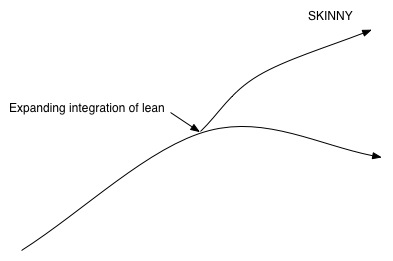|
|
| Figure 1 |
Lean is clearly not a passing fad, at least not like six sigma has been (at least that's my opinion). I find that the most significant contributor to lean's longevity for most organizations has been the resulting mindset that arises from successfully integrating lean and experiencing first-hand the resulting improvements in productivity. But what about organizations that have achieved this mindset shift and are seeking the next level of success?
Our research has repeatedly shown that businesses that have successfully integrated lean will eventually reach a plateau, the outcome of which is either stagnation in momentum, or worse yet, decline. Decline being the more common outcome as the law of atrophy takes over.
So the question at such a critical juncture becomes, "How can lean stagnation be mitigated, or even avoided altogether?"
Well, for many of our clients who have reached this very plateau, the next level of progression has become the insertion of lean concepts and practices into new and uncommon methodologies both inside and outside of the organization.
To capture the essence of what they are practicing, I coined the term "SKINNY," which stands for: Synchronizing Knowledge and Intelligence with the Necessary Nimbleness to maximize Yield. Despite the cliché, everyone can become SKINNY; it just requires challenging standard notions and beliefs relative to lean.
So at this point, you are likely wondering how exactly SKINNY is any different from lean. Well, let's shift this from the conceptual to the pragmatic. There are several unique attributes to companies that are practicing SKINNY. However, rather than explain them each here, I thought it might make more sense to provide you with some examples.
Let's start by looking at business strategy. Think about the typical strategy formulation and execution process, and then consider not how lean can be incorporated, but how the concept of lean can be used to develop a new strategy formulation process; one that provides an increased focus on the customer, with more robust objectives developed in less time than it takes the average person to weed their lawn. For the purpose of our discussions, I have outlined what each element of strategy looks like applying the SKINNY approach.
It's All in the Formula
Rather than packing your bags to head off to a relaxing strategy retreat for two, three or maybe even five days, companies that employ the SKINNY approach apply a rapid strategy formulation process focused exclusively on the end customer, both present and future. Using this approach, typically lengthy strategy sessions, where dozens of ideas are tossed around and discussed, are shortened in most instances to one day. The key is in how the session is prepared and facilitated to ensure an intense focus on the most desired outcomes. Try asking yourself, "Why does it take us several days to formulate our corporate strategy?" You will be surprised at your answer.
It's Not How You Say It; It's What You Say
If you have ever been part of a strategy formulation, you have likely experienced what I call the, "Go Forth and Do Good" stage. This is the point at which the carefully crafted strategy is passed, almost symbolically, to mid-level management. It reminds me of the passing of the torch during the Olympics. Organizations that employ SKINNY have recognized that the deployment of the strategic action plan is by far the most important step in ensuring the success of the strategy. Consider a company like Aviva UK, which engaged all levels of management when introducing its strategic plan in 2010. Aviva recognized that various means of communications were required to reach and engage employees around the organization's strategic objectives. Companies such as Aviva UK are going SKINNY, finding faster and more effective ways to build engagement and deliver on corporate strategy. When was the last time you had discussions with employees regarding your organization's strategic objectives (Notice I used the word "discussion" here.)?
Execute or Be Executed
We have all seen the studies. Most strategies fail in execution. We also know that the single greatest contributor to this common failure is the lack of engagement and ownership at the ground level. However, by deploying the strategy more effectively, we can virtually eliminate lack of engagement. The challenge then becomes ensuring that the execution of the strategy remains on track, and here again, companies that are moving beyond lean to employ processes such as Hoshin Kanri to drive a continued focus on the strategic objectives. The process results in actions that are simple yet effective, resulting in both engagement and commitment across all levels of the organization.
Now, some of you may in fact be going SKINNY and not even know it. To you, I would ask, "How are you going to further integrate these new practices and ensure you avoid the ever-looming stagnation?" But for those who have not considered how to further incorporate lean into the organization, going SKINNY might just be the answer you were searching for.
© Shawn Casemore 2013. All rights reserved.



